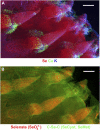Selenium accumulation, distribution, and speciation in spineless prickly pear cactus: a drought- and salt-tolerant, selenium-enriched nutraceutical fruit crop for biofortified foods
- PMID: 21059825
- PMCID: PMC3075757
- DOI: 10.1104/pp.110.162867
Selenium accumulation, distribution, and speciation in spineless prickly pear cactus: a drought- and salt-tolerant, selenium-enriched nutraceutical fruit crop for biofortified foods
Abstract
The organ-specific accumulation, spatial distribution, and chemical speciation of selenium (Se) were previously unknown for any species of cactus. We investigated Se in Opuntia ficus-indica using inductively coupled plasma mass spectrometry, microfocused x-ray fluorescence elemental and chemical mapping (μXRF), Se K-edge x-ray absorption near-edge structure (XANES) spectroscopy, and liquid chromatography-mass spectrometry (LC-MS). μXRF showed Se concentrated inside small conic, vestigial leaves (cladode tips), the cladode vasculature, and the seed embryos. Se K-edge XANES demonstrated that approximately 96% of total Se in cladode, fruit juice, fruit pulp, and seed is carbon-Se-carbon (C-Se-C). Micro and bulk XANES analysis showed that cladode tips contained both selenate and C-Se-C forms. Inductively coupled plasma mass spectrometry quantification of Se in high-performance liquid chromatography fractions followed by LC-MS structural identification showed selenocystathionine-to-selenomethionine (SeMet) ratios of 75:25, 71:29, and 32:68, respectively in cladode, fruit, and seed. Enzymatic digestions and subsequent analysis confirmed that Se was mainly present in a "free" nonproteinaceous form inside cladode and fruit, while in the seed, Se was incorporated into proteins associated with lipids. μXRF chemical mapping illuminated the specific location of Se reduction and assimilation from selenate accumulated in the cladode tips into the two LC-MS-identified C-Se-C forms before they were transported into the cladode mesophyll. We conclude that Opuntia is a secondary Se-accumulating plant whose fruit and cladode contain mostly free selenocystathionine and SeMet, while seeds contain mainly SeMet in protein. When eaten, the organic Se forms in Opuntia fruit, cladode, and seed may improve health, increase Se mineral nutrition, and help prevent multiple human cancers.
Figures







Similar articles
-
Quantification, localization, and speciation of selenium in seeds of canola and two mustard species compared to seed-meals produced by hydraulic press.Anal Chem. 2012 Jul 17;84(14):6024-30. doi: 10.1021/ac300813e. Epub 2012 Jul 6. Anal Chem. 2012. PMID: 22747111
-
Composition of chemical species of selenium contained in selenium-enriched shiitake mushroom and vegetables determined by high performance liquid chromatography with inductively coupled plasma mass spectrometry.J Nutr Sci Vitaminol (Tokyo). 2005 Jun;51(3):194-9. doi: 10.3177/jnsv.51.194. J Nutr Sci Vitaminol (Tokyo). 2005. PMID: 16161771
-
Synchrotron-based X-ray absorption near-edge spectroscopy imaging for laterally resolved speciation of selenium in fresh roots and leaves of wheat and rice.J Exp Bot. 2015 Aug;66(15):4795-806. doi: 10.1093/jxb/erv254. Epub 2015 May 26. J Exp Bot. 2015. PMID: 26019258 Free PMC article.
-
Effects of the Consumption of Prickly Pear Cacti (Opuntia spp.) and its Products on Blood Glucose Levels and Insulin: A Systematic Review.Medicina (Kaunas). 2019 May 15;55(5):138. doi: 10.3390/medicina55050138. Medicina (Kaunas). 2019. PMID: 31096667 Free PMC article.
-
The effects of Prickly Pear fruit and cladode (Opuntia spp.) consumption on blood lipids: A systematic review.Complement Ther Med. 2020 May;50:102384. doi: 10.1016/j.ctim.2020.102384. Epub 2020 Mar 27. Complement Ther Med. 2020. PMID: 32444049
Cited by
-
Synchrotron micro-computed tomography unveils the three-dimensional structure and origin of staminodes in the Plains Prickly Pear Cactus Opuntia polyacantha Haw. (Cactaceae).Protoplasma. 2023 Sep;260(5):1303-1312. doi: 10.1007/s00709-023-01846-6. Epub 2023 Mar 9. Protoplasma. 2023. PMID: 36890289 Free PMC article.
-
Indications of Selenium Protection against Cadmium and Lead Toxicity in Oilseed Rape (Brassica napus L.).Front Plant Sci. 2016 Dec 15;7:1875. doi: 10.3389/fpls.2016.01875. eCollection 2016. Front Plant Sci. 2016. PMID: 28018407 Free PMC article.
-
Selenium accumulation by plants.Ann Bot. 2016 Feb;117(2):217-35. doi: 10.1093/aob/mcv180. Epub 2015 Dec 29. Ann Bot. 2016. PMID: 26718221 Free PMC article. Review.
-
Wide field imaging energy dispersive X-ray absorption spectroscopy.Sci Rep. 2019 Nov 27;9(1):17734. doi: 10.1038/s41598-019-54287-8. Sci Rep. 2019. PMID: 31776410 Free PMC article.
-
Cytokinin is involved in TPS22-mediated selenium tolerance in Arabidopsis thaliana.Ann Bot. 2018 Aug 27;122(3):501-512. doi: 10.1093/aob/mcy093. Ann Bot. 2018. PMID: 29868879 Free PMC article.
References
-
- Andrahennadi RM, Wayland M, Pickering IJ. (2007) Speciation of selenium in stream insects using x-ray absorption spectroscopy. Environ Sci Technol 41: 7683–7687 - PubMed
-
- Bañuelos GS, Akohoue S. (1994) Comparison of microwave digestion with block digestion for selenium and boron analysis in plant tissues. Commun Soil Sci Plant Anal 25: 1655–1670
-
- Bañuelos GS, Lin ZQ. (2010) Cultivation of the Indian fig Opuntia in selenium-rich drainage sediments under field conditions. Soil Use Manage 26: 167–175
-
- Bañuelos GS, Lin ZQ, Arroyo I, Terry N. (2005) Selenium volatilization in vegetated agricultural sediment from the San Luis Drain, Central California. Chemosphere 60: 1203–1213 - PubMed
-
- Bañuelos GS, Lin ZQ, Wu L, Terry N. (2003) Phytoremediation of selenium contaminated soil and waters: fundamentals and future prospects. Rev Environ Health 17: 291–306 - PubMed

